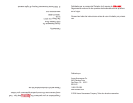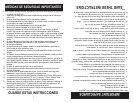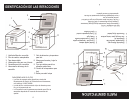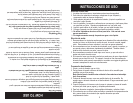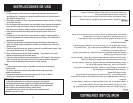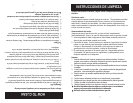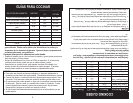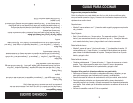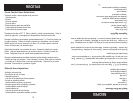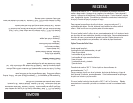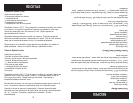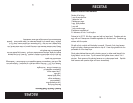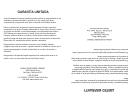
HOW TO USE
Before First Use:
1. Read all instructions and important safeguards.
2. Remove all packaging materials and make sure items are received in good
condition.
3. Tear up all plastic bags as they can pose a risk to children.
4. Wash the frying basket and nonstick frying pot with a sponge or dishcloth in warm
soapy water. Completely dry them with a dry cloth.
5. Wipe the inside of the unit and lid with a warm wet cloth.
6. Place the deep fryer on a level, stable surface.
¾ Do not use abrasive cleaners or scouring pads. Use soft non-abrasive
cloth.
¾ Do not immerse the appliance in water at any time.
Oil Selection:
1. We recommend the following oils for healthier deep-frying: corn, canola, or
blended vegetable oil. These oils are cholesterol-free and low in saturated fat.
2. We do not recommend using peanut oil, soy oil, sunflower oil, or lard that may drip
and deteriorate quickly when heated. Heavy flavored oil such as olive oil should
also be avoided.
3. We do not recommend mixing old and new oil together as this spoils new oil
quicker.
4. The number of times that the frying oil can be reused would depend on the food
that is fried in it. For example, when foods such as fish battered with bread or
cracker crumbs are fried frequently, the oil will need to be replaced more often.
Food Preparing:
1. Clean and cut the food you are going to fry.
2. Place uniform sized pieces of food into basket to ensure even frying.
Note: Never fill the basket beyond the max line and below the min. line.
3. Place food as dry as possible into basket. Do not add water or wet food into hot
oil. Water will cause the oil to splatter.
4. When you fry french fries, cut the husked potato into uniform sized pieces (this
prevents them from sticking) and dry them thoroughly.
5. When frying frozen foods, thaw thoroughly and remove the ice.
6. If the foods you are frying are pre-cooked, they need a higher temperature and
less cooking time than those foods which are completely raw.
5
INSTRUCCIONES DE USO
Antes Del Primer Uso:
1. Lea todas las instrucciones e importantes protecciones de seguridad.
2. Quite todos los materiales de empaque; asegúrese de que el aparato y
componentes estén en buenas condiciones.
3. Quite cualquier etiqueta de la superficie del tostador y limpie la superficie con
una toalla o paño húmedo.
4. Lave la canastilla y la cazuela no adherente con una esponja o toalla para platos
en agua tibia con jabón. Séquelos completamente con una toalla seca.
5. Limpie la parte interior de la unidad y la tapa con una toalla húmeda, tibia.
6. Coloque el aparato para freír sobre una superficie nivelada y estable.
¾ No utilice limpiadores abrasivos o fibras para tallar. Use una tela suave
que no sea abrasiva
¾ En ningún momento sumerja el aparato en agua u otro líquido.
Elección de aceite:
1. Recomendamos los siguientes aceites para tener alimentos fritos más saludables,
cuando los fría en un sartén hondo: aceite de maíz, de canola o aceite vegetal
mixto. Estos aceites no tienen colesterol y son bajos en grasas saturadas.
2. No recomendamos el uso de aceites de cacahuate, soya y girasol ni manteca, ya
que puede gotear y deteriorarse rápidamente al calentarse. También deberá
evitarse el uso de aceite con sabor, como el de oliva.
3. No recomendamos mezclar el aceite viejo con el nuevo, ya que esto echa a
perder más rápido el aceite nuevo.
4. El número de veces que el aceite para freír se puede usar de nuevo depende del
alimento que se haya frito en él. Por ejemplo, cuando se fríen frecuentemente
alimentos tales como pescado empanizado o mezclado con migajas de galleta, es
necesario reemplazar el aceite con más frecuencia.
Preparación de alimentos:
1. Limpie y corte el alimento que va a freír.
2. Ponga piezas de tamaño uniforme del alimento dentro de la canastilla para
garantizar que se frían parejas.
Nota: Nunca llene la canastilla más arriba de la línea máxima ni más abajo
de la línea mínima.
3. Coloque el alimento tan seco como sea posible dentro de la canastilla. No
agregue agua o alimento húmedo en el aceite caliente. El agua ocasionará que el
aceite salpique.
4. Cuando fría papas a la francesa, corte la papa sin cáscara en piezas de tamaño
uniforme (esto evita que se peguen) y séquelas perfectamente.
5. Para freír alimentos congelados, descongélelos totalmente y quíteles el hielo.
6. Si los alimentos que va a freír están precocidos, necesitarán una temperatura más
alta y menos tiempo de cocimiento que aquellos alimentos que están
completamente crudos.
5





